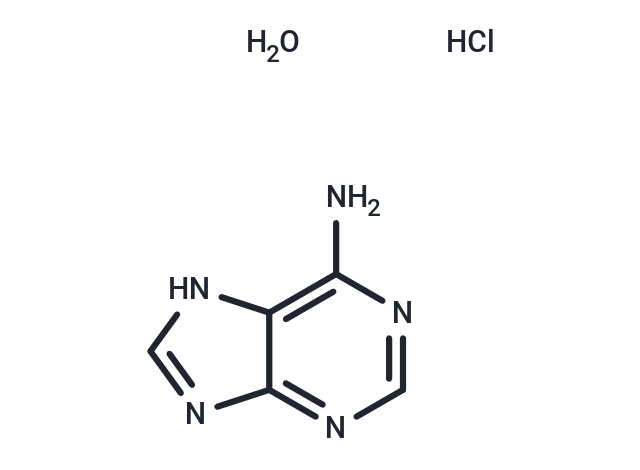Shopping Cart
- Remove All
 Your shopping cart is currently empty
Your shopping cart is currently empty

Adenine monohydrochloride hemihydrate is a high affinity adenine receptor agonist (Ki = 18 nM at rat adenine receptor). It inhibits forskolin-stimulated cAMP formation in CHO cells transfected with the adenine receptor and also stimulates GTPγS binding (pEC50 values are 8.54 and 7.21 respectively).

| Pack Size | Price | Availability | Quantity |
|---|---|---|---|
| 1 g | $29 | In Stock | |
| 1 mL x 10 mM (in DMSO) | $39 | In Stock |
| Description | Adenine monohydrochloride hemihydrate is a high affinity adenine receptor agonist (Ki = 18 nM at rat adenine receptor). It inhibits forskolin-stimulated cAMP formation in CHO cells transfected with the adenine receptor and also stimulates GTPγS binding (pEC50 values are 8.54 and 7.21 respectively). |
| Targets&IC50 | Adenosine receptor:18 nM (Ki) |
| In vivo | Procyclidine is used as antiparkinsonian agents because of their anti-cholinergic action is also known to have NMDA antagonist properties. Unlike other NMDA antagonists, this agents-because of their anti-cholinergic action-are devoid of neurotoxic side effects [1]. |
| Alias | Adenine hydrochloride hydrate, 6-Aminopurine hydrochloride hydrate |
| Molecular Weight | 189.6 |
| Formula | C5H8ClN5O |
| Cas No. | 6055-72-7 |
| Smiles | O.Cl.Nc1ncnc2nc[nH]c12 |
| Relative Density. | no data available |
| Storage | Powder: -20°C for 3 years | In solvent: -80°C for 1 year | Shipping with blue ice. | |||||||||||||||||||||||||||||||||||
| Solubility Information | DMSO: 50 mg/mL (263.71 mM), Sonication is recommended. | |||||||||||||||||||||||||||||||||||
Solution Preparation Table | ||||||||||||||||||||||||||||||||||||
DMSO
| ||||||||||||||||||||||||||||||||||||

Copyright © 2015-2025 TargetMol Chemicals Inc. All Rights Reserved.